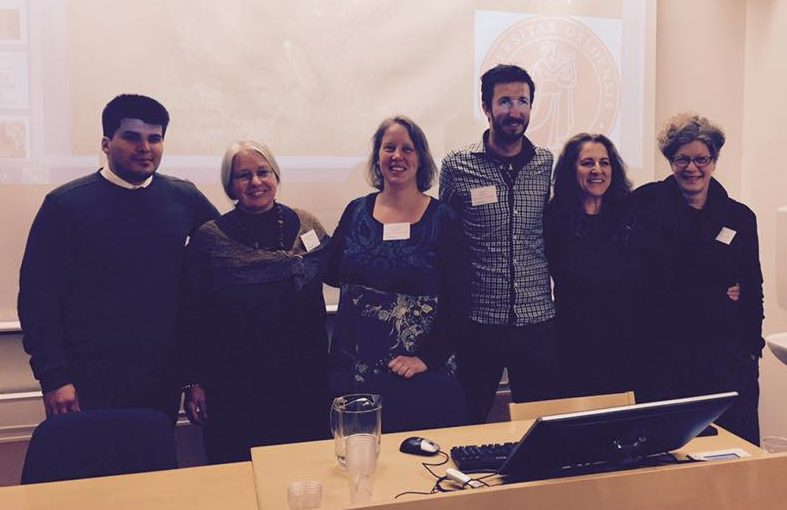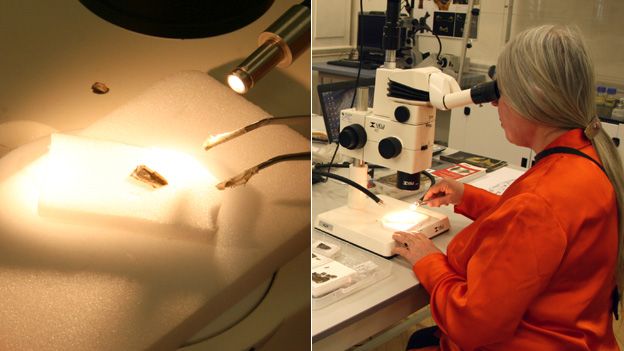Back in my undergraduate days we learned about Iron Age torcs. They were massive golden things, symbols of power and prestige. What exactly that power was, we didn’t know. They were made, used, and buried in the ground by people who had no written record. Our assumptions about power rested mainly in our own sets of values. But they are gold, valuable, and precious. Then there are other things that are just as valuable and precious, but more intangible…
A few years ago Tess Machling contacted me. She knew me as a jeweler/metalsmith turned archaeologist who had a passion for hammers and manufacturing processes. She had some photos and asked me what I thought. No details, just a question about what technique I would use to make something, or what would have caused this sort of mark. I enjoyed the puzzles. I told her how one photo was of metal that had been cracked because the smith had hammered it too much and the metal was fatigued. Could it the result of casting? No, the edges were too sharp, a casting flaw wouldn’t have a crack formed like that. In a few days I’d learn that other metalsmiths she asked told her the same things. She and Roland Williamson, a metalsmith with a background in making museum replicas, were searching for answers, and questioned everyone they could contact. Eventually I learned that we were corresponding about Iron Age gold torcs. The questions she asked us were set up like a blind test to avoid any bias. It was accepted knowledge that torcs were cast in gold and in the course of her research she was coming to the realization that the accepted knowledge was wrong.
The problems with institutions is that they lumber along and have difficulty changing. Even if they want to change, it occurs slowly. Most of the torcs were excavated and interpreted by antiquarians and archaeologists who never worked with metal and never thought to talk to someone who did. In my own research, time and again I came across ‘facts’ that had been passed along from one publication down the line that were just plain wrong. Tess and I both knew what she was up against. The entrenched ideas of institutions and people who uphold them are just as precious as gold. To have these ideas questioned seemed as great as affront as taking the One Ring from Gollum and declaring that it would be thrown into the fires of Mount Doom. But sometimes ideas do need to be cast away. Not randomly, but through careful research, examination, experimentation, and always questioning. I know that early on Tess did have doubts, but she and Roland had so much hard evidence that it was impossible to accept the status quo. Their hard work is changing the way we understand how Iron Age torcs were made. By examining tool marks they are identifying different techniques and seeing the smiths’ hands at work. They have found repairs, retrofits, and an entire catalogue of metalworking tricks of the trade.
In the course of their work, they have published articles in the The Proceedings of the Prehistoric Society, The Journal of the Historical Metallurgy Society, and the Later Prehistoric Finds Group Newsletter. But research is never static, it is something that is forever evolving and growing. As we all learned through this process, entrenched knowledge is terribly difficult to dislodge, even when it’s been proven wrong. There is also a need for transparency in research, and a way for the public to learn and participate in the process, free from paywalls. By producing their new website and blog, The Big Book of Torcs, Tess Machling and Roland Williamson are presenting their work for everyone to read, and question. It’s a wonderfully informative publication with a good bit of humour that will be useful for both the layperson and the academic, not to mention aspiring metalworkers!
Tag: metalsmithing
Nobody’s Perfect: Contrasts in Craft session at the Nordic Bronze Age Symposium
June 2017
It was my pleasure to present a paper at the Nordic Bronze Age Symposium in Oslo . The conference focused on contrasts and connections in the Bronze Age. Presenters covered a wide range of topics from landscape, technology, social practices and materialities.
The session that I participated in was titled Nobody is Perfect: Contrasts in Craft. I spoke about recognising the learning process by examining mistakes in metalwork. It was a great session and I hope that the research presented here will spur others to examine the flaws in objects to understand the processes of craft production.
Too often artefacts are selected for examination and display because of their perfection, but perfection can limit us. We see the end product but by the very process of achieving perfection the traces of the journey to mastery are erased. When we examine flaws, both minor and major, the world opens up.We can follow the movements of the artisan’s hands and see the sequence in which an object was made. We can see the choices made during production. Was there a flawed section of decoration because a master artisan was momentarily distracted, or was it because an apprentice was still awkward using tools? We can also question why the flaws remain; why the object survives, rather than having been destroyed or repaired.
The flaws, repairs, and mistakes all contribute to the object’s biography and allow us a glimpse of craft and decoration in ancient cultures. The papers presented in this session examined these and more subjects on mistakes in craft, and generated lively discussion.
“Nobody is perfect: contrasts in craft – for the first time at an archaeological conference artists, craftspeople and archaeologists gathered together to discuss the potential of mistakes, failures and repair within material culture of the past. The results were stunning: mistakes, failures and repair can not only help to identify skill level and apprenticeship in craft, they also indicate the intention, the actual purpose of an artefact.” – Heide W. Nørgaard
The Staffordshire Hoard and Me
In 2015 I had the honour to be a part of the team that helped reassemble the fragments of the Staffordshire Hoard at the Birmingham Museum and Art Gallery.
Many articles have been written about the hoard, how it was found by detectorists and how the archaeological team carefully excavated the field in order to recover every fragment of gold and garnet. It was a monumental undertaking, not only for the excavation, but also for the conservation work. My job was to assemble the fragments of embossed sheet metal, some of which were a couple millimeters wide. I started by photographing and cataloguing all the fragments using a camera with the capabilities of a microscope and could stitch multiple images together. Then by rote memorisation of all the bits, and with the help of chemical analyses done by Dr Eleanor Blakelock, I started putting the fragments of the panels and friezes together. Most of my days were spent looking through a microscope while I worked, handling the tiny fragments with pairs of tweezers. I’m proud of the work I did for the Hoard and for Birmingham Museums. There are some articles and blogs that have highlighted the work I did there.
The articles and video below go into greater detail about the work I did on the Hoard and have some good photos of a few of the embossed sheet metal foil.
BBC News: Staffordshire Hoard Reveals its Secrets
Staffordshire Hoard Newsletter
Staffordshire Hoard Video Blog
The conservation of the Hoard has won a major award (November 2015). Check out the video The ICON Conservation Awards.


